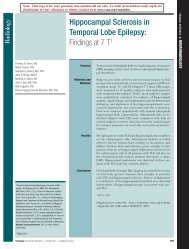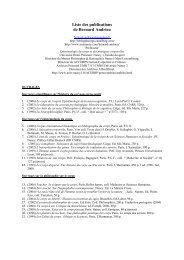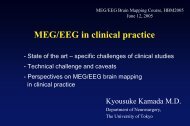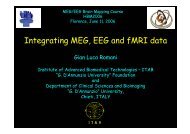th`ese de doctorat - Neurosciences Cognitives & Imagerie Cérébrale ...
th`ese de doctorat - Neurosciences Cognitives & Imagerie Cérébrale ...
th`ese de doctorat - Neurosciences Cognitives & Imagerie Cérébrale ...
Create successful ePaper yourself
Turn your PDF publications into a flip-book with our unique Google optimized e-Paper software.
AbstractNeuroimaging at the group level requires spatial normalization of individual structuraldata. We propose a geometric approach that consists in matching a series of corticalsurfaces through dieomorphic registration of their sulcal imprints. The resulting 3Dtransforms naturally extends to the entire MRI volumes. The DIeomorphic Sulcal-basedCOrtical (DISCO) registration integrates two recent technical outcomes : 1) the automaticextraction, i<strong>de</strong>ntication and simplication of numerous sulci from T1-weighted MRI dataseries hereby revealing the sulcal imprint and 2) the measure-based dieomorphic registrationof those crucial anatomical landmarks. We show how the DISCO registration maybe used to elaborate a sulcal template which optimizes the distribution of constraints overthe entire cortical ribbon. DISCO was evaluated through two dierent groups of individualbrains. Quantitative and qualitative indices attest how this approach may improve boththe alignment of sulcal folds and the overlay of gray and white matter volumes at thegroup level. A comparison with DARTEL [9] highlights how the lack of anatomical informationin non-linear iconic approaches may leads to sulcal mis-alignments while DISCOhelps avoid most of these ambiguities.Keywords: Neuroimaging, MRI, sulcus, volume and surface registration.RésuméSi les cerveaux <strong>de</strong> plusieurs individus présentent un certain <strong>de</strong>gré <strong>de</strong> similarité, lavariabilité <strong>de</strong> certains marqueurs tels que la taille, la forme voire la présence <strong>de</strong> certainssillons corticaux rend dicile l'i<strong>de</strong>ntication et la mise en correspondance spatiale <strong>de</strong>structures anatomiques ou fonctionnelles homologues. Cette variabilité inter individuellefascine car elle est contribue forcément à la diversité <strong>de</strong> personnalités et <strong>de</strong> capacitéscognitives qui font l'Homme. Elle frustre cependant les neuroscientiques car elle est unobstacle à l'intuition qu'une fonction a une position précise sur le cortex.Un nombre impressionnant <strong>de</strong> métho<strong>de</strong>s ayant pour objectif <strong>de</strong> minimiser cette variabilitéont été publiées mais beaucoup n'intègrent pas les informations anatomiques nécessairesà un alignement cohérent au niveau du cortex et ne sont valables que dans les régions3






